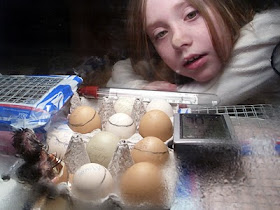Really, need I say more? If you had collected these beauties in the last four days, and the sun was shining, and you heard the peepers last night in the marshy fields, wouldn't YOU be hard pressed not to pull out the incubator?
 |
| Row 1+: Ameracauna X FCBM (OE F1s). Row 2: Olive Eggers (F2). Row 3/4: Black Javas. Row 4: FCBMs. |
|
Pull it out I did, because there is no hatch like the first hatch of Spring. I took the incubator top apart (ok, Latt helped) and cleaned it lovingly of all the detritus and fuzz that six hatches last year left behind. I got the top of the viewing area as clear as plastic gets, because 90% of the fun is in being able to REALLY see all the action. I found the hydrometer and the thermometer, I calibrated the former and tested the latter, and I set about setting eggs.
Veteran hatchers, especially those familiar with the economical wonder that is the Brinsea Eco 20, may notice that I have managed to get 25, not 24 eggs into the bator. This is the kind of gleeful success that only people crazy enough to get delight from the fact that they have just found a way to make sure they have another creature to keep alive, in hopes that it is a hen, experience. Still. Woot! 25, baby! With the success rate of this awesome incubator I wouldn't be a bit surprise if every one hatched. (Ignore the slight worried look--the kind that people have when fighting demonic possession, but only half-heartedly--that just ran across my face).

People who keep chickens are an odd bunch. Not as preternaturally strange as those who keep goats, mind you, but if you live with chickens, you change. You become the sort of person who really wants to home get by dusk and not linger over a second cup of coffee in the morning. You can't help it. You start to think about things like the amount of sunlight your place is getting, and the price of sunflower seeds, and you find yourself standing at the counter of your local feed store saying things like "Hmm. 16% the best you got? What do you have in game bird feed--unmedicated, I mean."
You find that ordinary things that make people happy, like hearing peepers on a mid-February night, make you think of baby chicks. And the sight of a humble little hen sitting so plainly and so wholeheartedly on her nest, with sun streaming into the coop, makes you think of all the cathedrals ever built to memorialize humans' own desire to capture a bit of creation and beauty.
You may find yourself saying to your husband, "I bet we can move the coops to the new house. We'll be able to save on cat carriers that way! The chickens can just ride in the coops. See how much sense it makes? Surely you and six friends can load them on a trailer. Can we borrow a trailer? And a truck with a hitch? It's only 110 degrees."
You find that you begin to moralize and have a deep sense of judgment and even hatred for parts of the animal kingdom previously seen as "cute" or "cool", like raccoons, which I now very seriously consider the Reavers of the small-farm universe. (For those who have not seen the series Firefly, which introduced me to this scariest of villains: picture a rabid, radioactively-insane species whose entire reason for being is to claw and maul its way into your spaceship--or chicken coop, whatever--and cause as much sadistc mayhem as possible, including decapitation and entrail eating, seemingly for fun.)
In short, if you start keeping chickens, and you do so for any length of time, and don't shake yourself out of it, you will find yourself an anachronism, talking about tending animals in a way that has all but disappeared in modern America, feeling a deep sense of engagement with the natural world, and the homey sense of self sufficiency and cosmic subversion that only filling one's tank with gas and paying with a wad of thirty-six ones, your egg money from the month, will give you. You'll find yourself wondering if Wendell Berry is too old to run for president.

So yeah. I have 20 more days to ruminate on the simple, rustic, Americana-esque beauty of hatching birds and keeping chickens, which is pleasant philosophical work I neglect in the Fall moult and the dearth of eggs it brings, and during the Winter of short days and weatherizing coops and more work than really can be done between the time you get home and the birds needing to be put up. The culmination of this incubation period will be three days of obsessing and watching and little sleep, and worrying about the little ones who have trouble getting themselves into this world, and the magic climax of seeing them emerge, one by one, wet and wobbly.
Then I'll have about three days of thinking about how cute baby chicks are, and three weeks of plotting to get them the hell out of my house, and five more weeks worrying about the dog or cat getting them in the garage brooder, and four months of worrying about hawks. Then a lifetime of worrying about Reavers getting them.
And in the meantime, I'll hatch a bunch more chicks, sell a bunch more birds, and find myself talking to elderly men and women about things that never got mentioned in classes like Women's Studies or Liberation Theology or Social Movements, but, I think, are making me a better person, and a little more substantial and poetic, to boot.
- Posted using BlogPress from my iPhone







































